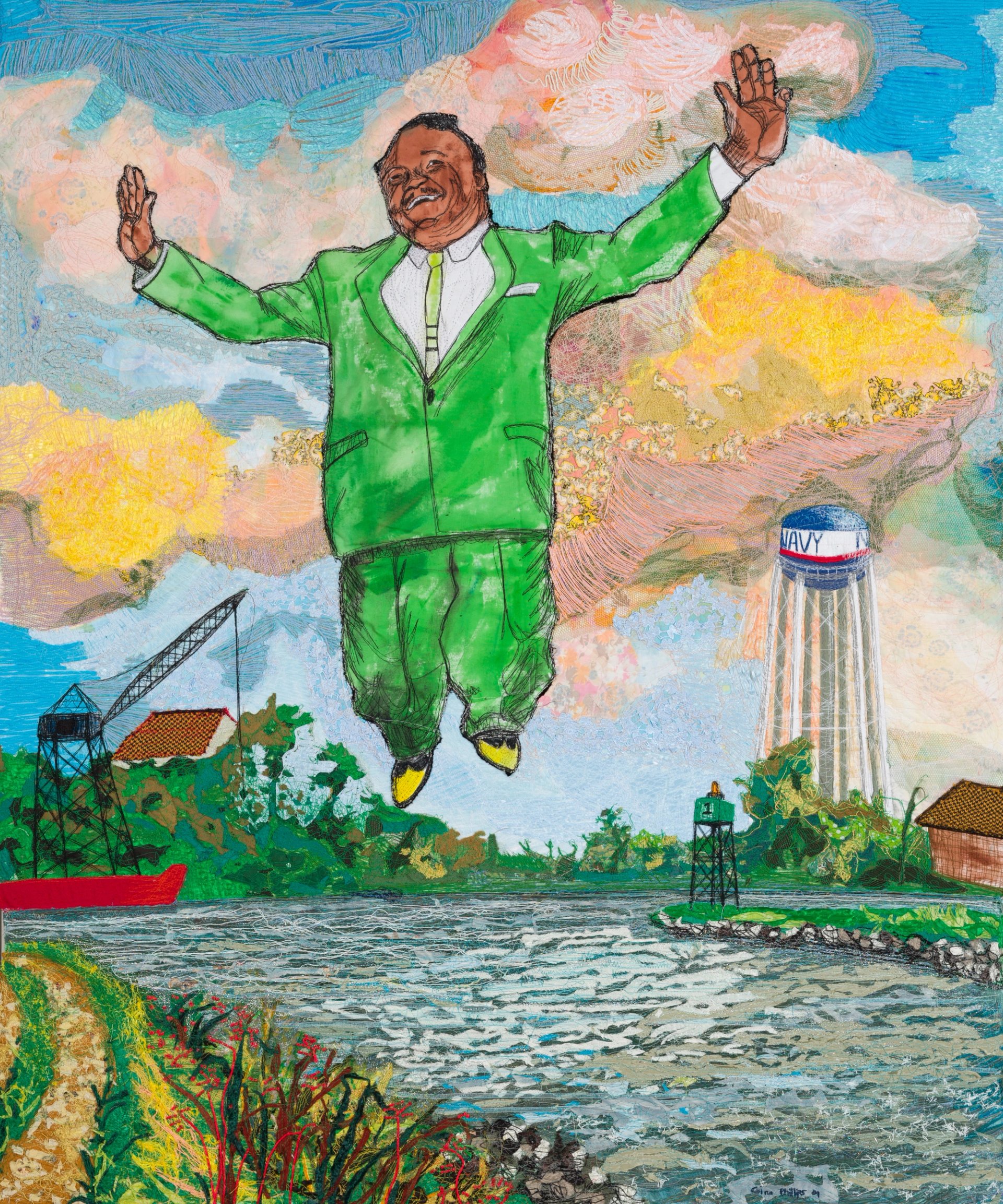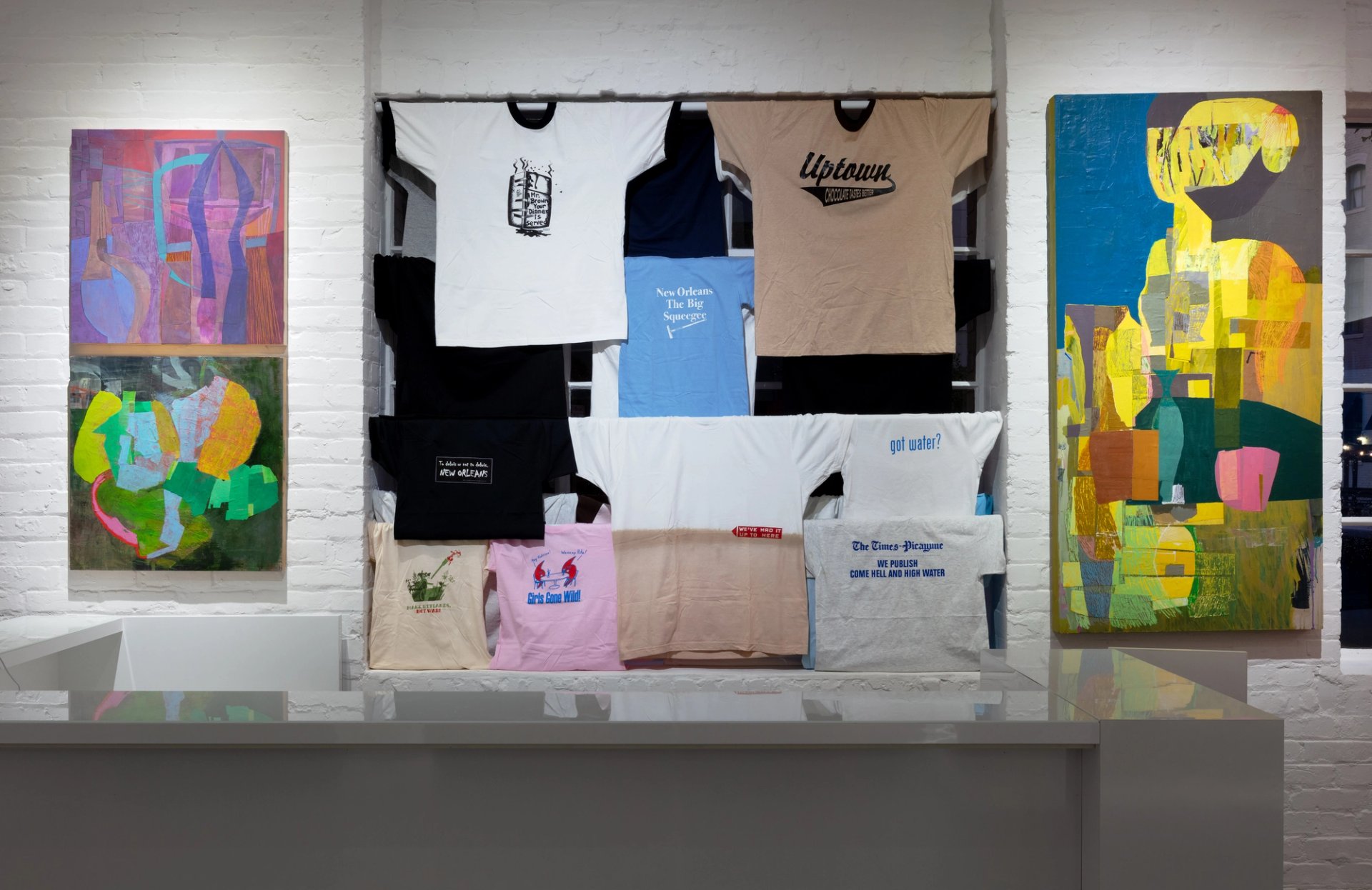This month marks the twentieth anniversary of Hurricane Katrina. One of many deadliest storms in US historical past, it resulted within the demise of an estimated 1,400 individuals, in response to latest authorities figures. An ongoing group present at Ferrara Showman Gallery in New Orleans explores how the storm modified town and the native artwork scene, and the way artists have labored to reinvest in New Orleans within the twenty years since.
The gallery celebrated the opening for This Metropolis Holds Us earlier this month on White Linen Evening, New Orleans’s annual artwork block occasion. Revelers wearing breezy summer season garments and handed by way of the 20 or so artwork galleries lining Julia Road within the metropolis’s historic Warehouse Arts District. Round 35,000 guests handed by way of that night, says gallery founder and accomplice Jonathan Ferrara, a lot of them extra engaged with the present than normal.
“That was distinctive,” Ferrara tells The Artwork Newspaper. “It was actually a beautiful factor to see. It would not occur that always.”
The exhibition, which invited artists to revisit their experiences throughout and after Hurricane Katrina, could have struck a chord with the native viewers. New Orleans, Louisiana’s most populous metropolis, was the toughest hit by the class 5 storm. Inside per week of its landfall on 29 August 2005, round 80% of New Orleans was underwater, in some areas as deep as 20ft, after its system of levees and floodwalls failed.
Whereas an estimated 80% of New Orleans’s residents evacuated earlier than the storm, 1000’s of town’s most weak lacked transportation or sources to comply with authorities’ short-notice evacuation orders. Many sought shelter within the Louisiana Superdome, the native indoor area. Studies of unsanitary circumstances, violence, crime and even demise turned the “shelter of final resort” into a logo of the institutional failures that left New Orleans residents to endure within the wake of Katrina. The Federal Emergency Administration Company (Fema), the federal government division charged with co-ordinating catastrophe response, was broadly criticised, prompting agency-wide reforms. (This week, US media retailers reported dozens of Fema workers have been placed on go away after warning in an open letter that US President Donald Trump’s cuts to the company threaten to undo these enhancements).
“We have been the canary within the coal mine with regard to large-scale pure disasters,” Ferrara says. “It confirmed a number of the inadequacies of the federal system on many alternative ranges.”
Work by artists Anastasia Pelias, Jonathan Ferrara (additionally the gallery’s founder) and Gina Phillips. Photograph by Mike Smith, courtesy Ferrara Showman Gallery
Whereas the resilient metropolis has made important progress in rebuilding, restoration has been uneven—in the present day, the inhabitants remains to be beneath pre-Katrina ranges, particularly in traditionally Black neighbourhoods just like the Decrease Ninth Ward, which endured a number of the deadliest flooding.
When Ferrara and gallery director and accomplice Matthew Weldon Showman started considering the concept of a present devoted to the twentieth anniversary of the storm, they knew they wished to maintain the give attention to the progress New Orleans and its artists have made since Katrina, not on the imagery related to the destruction.
“What actually units us aside—and this has been the suggestions from our patrons—is that we now have taken on this new perspective relatively than trying again,” says Showman, who curated the exhibition. “We’re honouring the previous, however it’s triumphant and celebratory of how far we have come, and what we now have nonetheless but to do within the metropolis.”
‘The expertise is a part of my make-up now and solely made me stronger’
This Metropolis Holds Us options work by ten artists who have been affected by Katrina. Showman had artists submit written testimonies reflecting on how the storm formed their lives and artistic practices. The multidisciplinary artist Anastasia Pelias, a New Orleans native, has a number of summary work on show.
“I hate revisiting the trauma of Hurricane Katrina and its aftermath,” she wrote in her testimony. “The individuals of New Orleans weren’t protected by the powers that be, on this case the Military Corps of Engineers, who knew that our levees have been unstable and {that a} disastrous occasion was not only a chance, however was imminent… the entire residents of New Orleans have been betrayed, however the pointedly inequitable therapy of various demographics—individuals in low-income neighbourhoods—instantly grew to become very clear. New Orleans was uncovered for its nice racial and socioeconomic disparities and divide.”
Katrina “shredded our complete ecosystem and infrastructure, not simply within the arts, however generally”, Ferrara says. “At first, artists have been simply attempting to outlive. Individuals weren’t centered on shopping for artwork; they have been rebuilding their partitions.”
However slowly, from that wreckage, a starting-from-scratch mentality allowed some artists to reinvent their practices after the storm. Within the wake of destruction, some drew recent inspiration from New Orleans’s distinctive mix of Caribbean, French, West African and Southern cultural influences.

Fat Bought Out (2025) by Gina Phillips Courtesy Ferrara Showman Gallery
“It was like dwelling in a petri dish—something was doable, nothing was possible,” Ferrara says. “Those who stayed have been zealous. They have been those that stated: ‘I’m not leaving.’ And one of many issues that stored these individuals there was the tradition, the music, the meals, the artwork, the literature, all of these issues that make New Orleans an incredible place.”
The mixed-media artist Gina Phillips misplaced practically the whole lot within the storm when her dwelling studio flooded. Afterwards, she spent two years in a Fema trailer (a caravan that was presupposed to be short-term shelter) and used a grant to buy a longarm quilting machine. This instrument allowed her to discover new themes—place, historical past, geography—in thread and cloth, impressed by New Orleans. “It’s been 20 years since Hurricane Katrina—arduous to consider. Additionally arduous to consider I’m about to say this—however I wouldn’t change something,” Phillips wrote. “The expertise is a part of my make-up now and solely made me stronger.”
The photographer Trenity Thomas was solely six years previous when she evacuated. Her footage within the exhibition present acquainted New Orleans scenes, like shotgun home porches, second line road parades and the well-known Café Du Monde.
Aimée Farnet Siegel, one other artist featured within the present, solely started her artwork observe after the storm. She felt impressed within the wake of Katrina, when she “discovered a metropolis reworked—scarred, resilient and decided”, Siegel wrote. What struck her most have been the T-shirts locals wore after Katrina. Some slogans on the shirts expressed indignation on the authorities’s negligence, whereas others used humour to poke enjoyable on the chaos. She gathered 81 of them for an additional gallery present, a few of that are additionally on show at Ferrara Showman Gallery, with sayings like “I stayed in New Orleans throughout Katrina, and all I bought was this awful T-shirt, a brand new Cadillac and a plasma TV” and “Make Levees, Not Warfare”. Siegel later turned to portray, and three of her latest canvases are included within the exhibition. “Very like my beloved New Orleans, my work is continually altering and evolving, carrying inside it the ruins and the renaissance—proof that therapeutic, rebuilding and flourishing are doable,” Siegel wrote.

Two work by Aimee Farnet Siegel, and t-shirts she collected within the wake of Hurricane Katrina. Photograph by Mike Smith, courtesy Ferrara Showman Gallery
Most featured artists within the present are from or based mostly in New Orleans; solely the sculptor Paul Villinski is just not native. He visited shortly after Katrina in 2006 to scavenge supplies for his work, usually made with discarded objects. This present consists of items created from vinyl data that Vilinski got here throughout within the Decrease Ninth Ward. The vinyl had been warped from hours sitting within the solar, the spherical heart labels rotted away. Villinski reshaped them into birds.
“In some methods, the storm propelled the artwork scene right here in New Orleans. The highlight on town and the tragedy that occurred right here additionally invested public curiosity in what got here of town afterwards,” Showman says.
Ferrara and Showman credit score Prospect New Orleans, the contemporary-art triennial that started in 2008 as a response to Katrina, as serving to reinvigorate artwork within the metropolis and even rising the artwork scene to past what it was earlier than the storm. (Prospect’s organisers introduced final month they’d skip the 2027 iteration and publish an anniversary ebook as an alternative. It stays to be seen if future editions of Prospect New Orleans will happen).
“The highlight got here due to Katrina, which isn’t essentially what you need, however it’s what it’s,” Ferrara says. “We’ve got stood up underneath the highlight as an artist neighborhood.”
Different galleries and establishments throughout the larger New Orleans space are marking the anniversary with exhibitions as nicely. The New Orleans Museum of Artwork is internet hosting A Time Earlier than Katrina (till 21 September), an exhibition of dense and richly detailed works on paper by Dapper Bruce Lafitte, an artist based mostly within the Decrease Ninth Ward. The New Orleans Academy of Nice Arts has teamed up with ArtsvilleUSA and the River Arts District Artists in Asheville, North Carolina, to placed on A Story of Two Cities (13 September-8 November), marking the anniversaries of each Hurricane Katrina and 2024’s Hurricane Helene—the deadliest storm to strike the continental US since Katrina. In the meantime, the New Orleans African American Museum is staging a year-long present known as The Katrina Checklist: An Untold Story of Hurricane Katrina (28 August 2025-30 August 2026), bringing collectively survivors’ testimonies, images, handwritten letters and salvaged objects to supply the general public an interactive memorial to the human impression of the storm.
This Metropolis Holds Us, Ferrara Showman Gallery, New Orleans, till 13 September








